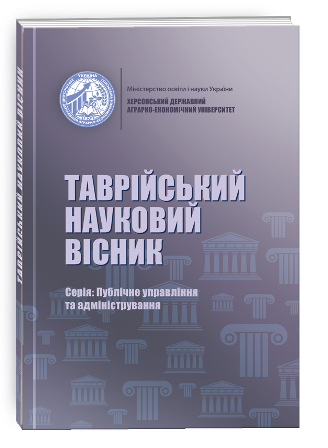TRADITIONAL AND NEW CONCEPTS OF PUBLIC ADMINISTRATION
DOI:
https://doi.org/10.32782/tnv-pub.2025.1.7Keywords:
public administration, concept, old public management, new public management, new public serviceAbstract
Public administration and the approaches applied to it today are significantly different from those that originated at the end of the 19th century. In recent years, new models and concepts have emerged that have been implemented in industrially developed countries. Given this, the article aims to study and analyze existing public administration concepts, identify their advantages and disadvantages, determine the scope of application, specify the subjects and objects of management, and the processes of their interaction. It is noted that the essential elements of any concept of public administration are a target system, a functional structure, a variety of management tools and processes, a general morphology, and a system of results. It has been established that most authors propose to consider the following as separate concepts of public administration: traditional public administration, new public administration, and new civil service. The conventional idea of public administration is based on a "top-down" approach. Therefore, management subjects are independent and do their activities without interacting with politicians and citizens. However, in their work, they should still be guided by the principles of integrity. The main emphasis of this concept is on creating an effective organizational structure of management and a hierarchy of command and control decisions. A completely different approach underlies the latest concepts of public administration that appeared in the second half of the 20th century. They are based on the principles of democracy, constant supervision of the work of public sector managers, and accountability. And their central aspect is serving the good of society, not management. That is, the benefit to society is the main factor motivating work. Many developed countries, including the OECD and the USA, have supported these concepts. They are also widely implemented in the reform of the state apparatus at all levels in developing countries. However, each of these concepts (both old and new) has its advantages and disadvantages. Therefore, this must be considered when using them to reform the public apparatus in Ukraine.
References
Boston J., Martin J., Pallot J. Public management: The New Zealand model Auckland: Oxford University Press, 1996.
Bourgon, J. Responsive, Responsible and Respected Government: Towards a New Public Administration Theory. International Review of Administrative Science. 2007. vol. 73. No. 1. P. 7–26.
Denhardt, J. V. and R. B. Denhardt. The New Public Service: Serving, Not Steering. 3rd Edition. Armonk, NY: M. E. Sharpe. 2011.
Dunleavy, P. and C. Hood. From Old Public Administration to New Public Management. Public Money & Management. 1994. vol. 14. No. 3. P. 9–16.
McCourt, W. Models of Public Service Reform: A Problem-Solving Approach. Policy Research Working Paper, 2013. No. 6428. Washington D.C: The World Bank. URL: http://www-wds.worldbank.org/external/default/WDSContentServer/WDSP/IB/2013/04/30/000158349_20130430082936/Rendered/PDF/wps6428.pdf
Osborne, S. P. The New Public Governance? Public Management Review. 2006. vol. 8. No. 3. P. 377–388.
Rao, S. Civil Service Reform: Topic Guide, Birmingham, UK: Governance and Social Development Resource Centre (GSDRC), University of Birmingham. 2013. URL: http://www.gsdrc.org/go/topic-guides/civil-service-reform
Quah, J. S. T. Ensuring Good Governance in Singapore: Is This Experience Transferable to Other Asian Countries? International Journal of Public Sector Management. 2013. vol. 26. No. 5. P. 401–420.
Сучасні підходи і напрями розвитку публічного управління та адміністрування: підручник / за ред. д-ра наук з держ. управління, проф. В. Д. Бакуменка; ДБТУ. Харків: Майдан, 2022. 280 с.
Береза А. Сучасні підходи до модернізації публічного управління. Наукові записки. 2011. Випуск 6 (56). С. 144–153.
Дзюба Г. Концепція «New Public Management»: основні елементи. Галицький економічний вісник. 2023. №4. С. 141–151.
Robinson, M. The Politics of Successful Governance Reforms: Lessons of Design and Implementation. Commonwealth and Comparative Politics, 2007. vol. 45. No. 4. P. 521–48.
Roll, M. The Politics of Public Sector Performance: Pockets of Effectiveness in Developing Countries. London: Routledge. 2014.
Torfing, J., L. B. Andersen, C. Greve, and K. K. Klausen. Public Governance Paradigms: Competing and Co-Existing. Cheltenham: Edward Elgar. 2020.
Torfing, J., and C. Ansell. Co-Creation: The New Kid on the Block in Public Governance. Policy & Politics 2021. 49 (2). P. 211–230.
Krogh, A. H., & Triantafillou, P. Developing New Public Governance as a public management reform model. Public Management Review. 2024. 26(10). P. 3040–3056.







